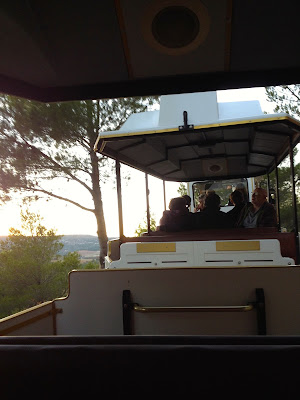These are a few tips from me as how to taste a wine. They start with the appearance of the wine and then on to the nose and palate. If you try and taste some wines whilst looking at this list then it will allow you to appreciate the wines and help you understand them as they tend to be pretty complex things. So give it a go!
Appearance
It is important to look at the wine before you smell it as it can tell you a lot about the wine before you even start!
1. Colour
-This can give an indication of how old the wine is.
- For White wines, a lemon/ light green colour means that it
is a young wine, an older wine will be a darker yellow colour, verging on brown
in some instances. This darker colour comes from the barrels that it is
fermented in.
- The colour in Red wines can show the body of the wine. A
light red colour will mean it is lighter and a dark red colour will have more
depth and body. To see the colour of the red, look at the edges of the glass.
2. Tears/ Legs
When you swill the wine around the glass and let it settle
you can see the wine marks on the side of the glass – these are called the
tears or legs. They come from the amount of glycerol in the wine, so if there
are more legs then the wine has more body and a higher sugar content. They are
generally more apparent in Red wines. It shows how ‘heavy’ the wine is.
Nose
You can gather a lot about the wine just by smelling it. It helps to give the wine a swill around the glass first and also to have a sip of it as this allows the flavours to develop and change in your airways.
1. Smell
- Check that the smell is clean first and that it does not
have cork taint or smell ‘off’.
- It is easy to pick up 2 aromas to begin with. These tend
to be either fruity or floral scents. After your first sip of the wine, smell
again and the flavours will change and become more apparent- you will be able
to pick up other scents like vegetal/ spicy/ earthy etc.
- When you swill the wine you bring oxygen in to the wine
which releases flavour but also the alcoholic scent.
- You can smell the age. If it is a younger wine it will
smell fruity/ floral. For a white wine there will be green fruit notes like
apple and citrus.
Palate
This is the enjoyable part! Really let the wine sit in your mouth for a little while rather than swallowing straight away. And try to take some breaths through your nose as this allows the oxygen to meet with the wine and intensify the flavour.
1. Acidity
The younger a wine is the more acidity it will have.
2. Dryness/ sweetness
If a wine has some acidity then it will usually be a dry
wine with little or no sweetness. And the sweeter a wine is then the less
acidity there will be.
3. Tannins
Tannins are mostly found in Red wines. These can either be
light or heavy and they coat the mouth.
4. Alcohol
The presence of the alcohol is easy to detect, sometimes it
can be a little too over powering. But it can be important in giving balance to
a wine.
5. Finish
The length of the wine is a combination of the
sweetness/ alcohol and acidity. It can either have a short or long finish.
Usually light wines have a short finish, where as more bodied wines have a long
taste that lingers on the palate.
xXx



























































